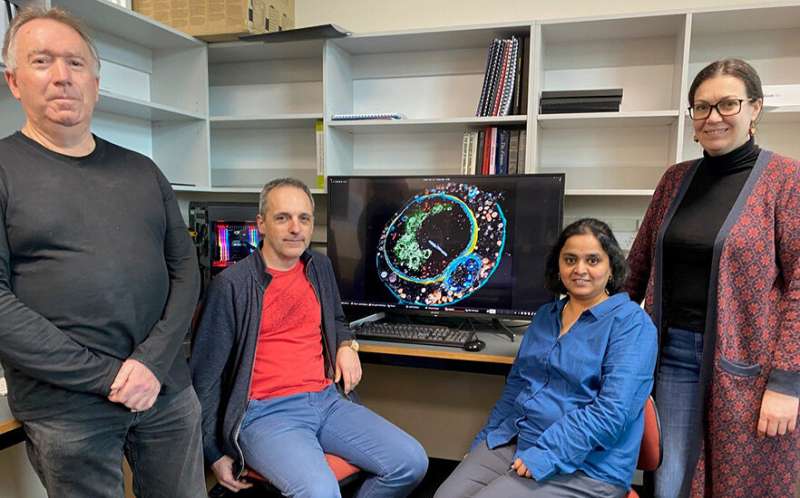Co-authors of the recent research project (from left) Allan Mitchell, Dr Mihnea Bostina, Sai Velamoor and Dr Laura Burga. Credit: University of Otago
University of Otago researchers have learnt more about how viruses operate and can evade the immune system and are now using their discovery to help learn more about COVID-19.
The recent research, led by Dr. Mihnea Bostina and Ph.D. student Sai Velamoor from the Department of Microbiology and Immunology and Otago Micro and Nano Imaging, Electron Microscopy, specifically looked at the Oryctes rhinoceros nudivirus (OrNV) virus, an important biocontrol agent against the coconut rhinoceros beetle, a devastating pest for coconut and oil palm trees in Southeast Asia and the Pacific Islands.
The Otago scientists found the virus used a "decoy" strategy to evade the immune system. Dr. Bostina explains the findings are a small step in the bid to better understand infectious disease.
The research team is now using the same technique to investigate changes in cells infected with SARS-CoV-2, the coronavirus that causes COVID-19.
"We have used the same technique to investigate changes in cells infected with SARS-CoV-2 and are continuing work in this area."
Dr. Bostina explains that viruses that replicate and assemble inside the nucleus have evolved special approaches to modify the nuclear landscape for their advantage. The research team used electron microscopy to investigate cellular changes occurring during nudivirus infection and found a unique mechanism for how the virus works.
"Our study revealed that the virus acquires a membrane inside the nucleus of the infected cell and it gets fully equipped to infect new cells at this precise location. This is in contrast with other enveloped viruses—like coronavirus, which is also an enveloped virus—which derive their membranes from other cellular compartments.
"After it gets fully assembled, the virus uses a clever tactic of passing through different environments, packed inside various membrane structures until it gets released at the cellular membrane."
Ms Velamoor says this strategy implies that many of the viruses released by the infected cells will be enclosed in a cellular membrane while travelling inside the infected organism.
"This means they will be missed by the immune system and they can use this membrane decoy to penetrate any other type of cells, without the need of a virus specific receptor.
"It shows for the very first time a clever strategy available to insect viruses. It will be interesting to find in what measure other types of viruses—like the ones infecting humans—are also capable of carrying out a similar process."
Dr. Bostina says the research demonstrates another manner in which viruses are capable of hijacking infected cells and alerts scientists to the novel mechanism of viral transmission.
"Viruses will never cease to amaze us with their indefatigable arsenal of tricks. Only by studying them can we be prepared to adequately respond when they infect us."
The research has just been published in mBio, a science journal published by the American Society for Microbiology.
More information: Sailakshmi Velamoor et al. Visualizing Nudivirus Assembly and Egress, mBio (2020). DOI: 10.1128/mBio.01333-20
Journal information: mBio
Provided by University of Otago
























